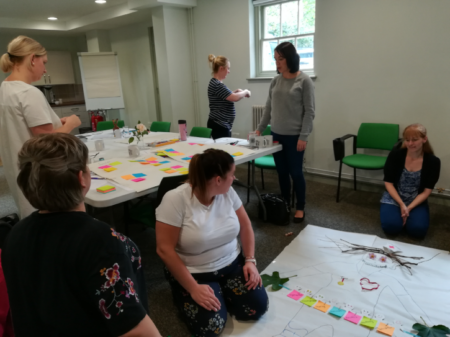Home News & Views Providing a safe space for people to grow and develop
Providing a safe space for people to grow and develop

Deb Smith, Ward Manager, Royal Manchester Children’s Hospital
Putting yourself and your team under a microscope and really hearing your staff can lead to uncomfortable self-reflection but also amazing unseen development opportunities for staff.
As an Inspire Improvement Fellow I asked staff ‘what is it like to work around here?’ This feedback highlighted that the way we interact, work and speak to each other could be improved to help the ward to be a more cohesive and supportive place to work. Discussing the results with Jo (from FoNS), we realised we needed to focus on the development of the whole leadership team within the ward.
Jo kindly agreed to facilitate an away day for the senior leadership team made up of myself and the band 6 nurses. The programme for the day was designed and planned using my claims, concerns and issues from the feedback of ‘what it was like to work around here’.
To give everyone the space and opportunity to completely remove themselves from work, I hired a room at Elizabeth Gaskell’s House (a beautiful historical home in Manchester). As the team have known each other for a long time (or so we thought), I asked them to bring an artefact to introduce themselves and share something of themselves that no one knew. To our surprise we discovered hidden talents, strengths and interests: drawing, gardening and acrobatic talent! It’s also wonderful to see how proud people are of the things they have achieved, done and love to do in their lives!
We then set out to explore the purpose of the leadership team using a values clarification exercise. We agreed what the purpose of our leadership team should be and how we could achieve it. We acknowledged what would help and also what could hinder this and how we might mitigate those factors. Through exceptional creativity, the team visually expressed their values and beliefs and the purpose of the leadership team.
To provide a deeper understanding of what we are trying to achieve, the team watched the ‘Creating Caring Cultures‘ animation. We discussed in depth how we know that caring for patients and staff is happening, what evidence we have and whether we use that evidence to prove or actually improve care. The choice of the words we use was challenged and whether evidence from staff and patients expressed their satisfaction alone or described their experiences. The team were introduced to other methods they might use in order to understand what is happening on the ward, such as use of the Evoke Cards, observation of care and the use of emotional touchpoints. We finished the day by using a collective claims, concerns and issues exercise to celebrate what was going well at the moment, what our concerns were and used these to develop an action plan.
The team found the day enjoyable, exhausting and very thought provoking! A significant number of questions (issues) were raised for us all that could be dealt with easily in a more caring and compassionate way using reflection and the tools we were introduced to.
So what’s my message to you? The provision of a safe space away from work allowed the team to relax and focus on understanding what we are trying to achieve. It gave them the time to reflect on how even the smallest changes such as asking ‘how are you all feeling today?’ at handover or using open questions when asking how staff are coping with their day could have a big impact on staff relationships and wellbeing.
Now what happens is perhaps the most difficult of all! As nurses we like to immediately fix identified issues. Sitting back and allowing, or waiting, for others to take the lead does not come naturally, but if we do not give them the opportunity to put into place what they have learned, how will the team grow and develop? And how can the culture of the ward evolve if I impose the changes rather than the changes coming from the team?
I’ll let you know what happens!
Comments are closed.

